Like botanical warriors standing guard against winter’s relentless assault, cold hardy native plants represent your best allies for creating a thriving North Dakota garden. You’ll discover that these resilient species don’t just survive temperatures plunging to -40°F, they actually flourish in conditions that would kill most ornamental varieties. However, choosing the wrong native can still spell disaster for your landscaping investment, and there’s one critical factor most gardeners overlook.
Contents
- 1 North Dakota’s Harsh Prairie Climate
- 2 Prairie Wildflowers for North Dakota
- 3 Cold-Tolerant Native Trees
- 4 Hardy Shrubs for Winter Survival
- 5 Selecting the Right Native Plants for Your Garden
- 6 Frequently Asked Questions
- 6.1 How Do I Propagate Native North Dakota Plants From Seeds?
- 6.2 When Is the Best Time to Plant Native Species in North Dakota?
- 6.3 Do Native Plants Require Special Fertilizers or Soil Amendments?
- 6.4 How Much Water Do Established Native Plants Need During Summer?
- 6.5 Can Native North Dakota Plants Survive Without Winter Protection?
North Dakota’s Harsh Prairie Climate
While most gardeners worry about occasional frost, North Dakota’s climate throws everything at your plants like nature’s stress test. You’re dealing with winter lows hitting -60°F and summer highs exceeding 90°F, creating massive temperature swings that demand serious climate adaptability.
Your growing season battles 14-20 inches of annual precipitation, mostly concentrated in late spring and summer. High evapotranspiration rates nearly cancel out rainfall, especially in upland areas where drought resilience becomes essential for plant survival.
Add constant winds, frequent blizzards, and soil moisture that disappears quickly, and you’ll understand why only the toughest native species thrive here naturally. The state’s continental climate creates unpredictable weather patterns that can shift dramatically between seasons, making adaptation critical for plant survival.
Prairie Wildflowers for North Dakota
North Dakota’s prairies showcase over 50 native wildflower species that bloom throughout the growing season, providing essential wildlife habitat while displaying remarkable adaptations to harsh prairie conditions. These prairie wildflowers offer crucial support for local wildlife populations, including declining bird species, native pollinators, and other insects that depend on native plant communities for survival.
Purple Prairie Clover

Purple Prairie Clover (Dalea purpurea) is a hardy native perennial that brings vibrant magenta-purple blooms to North Dakota landscapes from May through August. This drought-tolerant wildflower produces distinctive thimble-shaped flower clusters that bloom progressively from bottom to top, extending the display period. Growing 1-3 feet tall with slender stems and narrow leaflets, it’s an excellent choice for prairie gardens, pollinator habitats, and naturalized areas.
As a member of the legume family, Purple Prairie Clover fixes nitrogen in the soil while attracting bees, butterflies, and other beneficial insects. Its deep taproot system makes it extremely drought-tolerant once established, and it requires minimal maintenance. This deer-resistant wildflower works beautifully in native plant mixes and prairie restoration projects, providing both ecological value and long-lasting color. The plant thrives in calcareous soils, making it well-suited to alkaline conditions common in many prairie regions.
- Hardiness: Cold hardy perennial, well-suited to North Dakota’s harsh winters
- Light: Full sun
- Water: Dry to mesic conditions; drought tolerant once established
- Soil: Well-drained soils; does not tolerate wet or waterlogged conditions
- Fertilizer: None needed; fixes its own nitrogen from the atmosphere
- Pest/Disease Resistance: Deer resistant and generally pest-free
- Growth Rate: Moderate; takes time to establish deep taproot system
Black-Eyed Susan
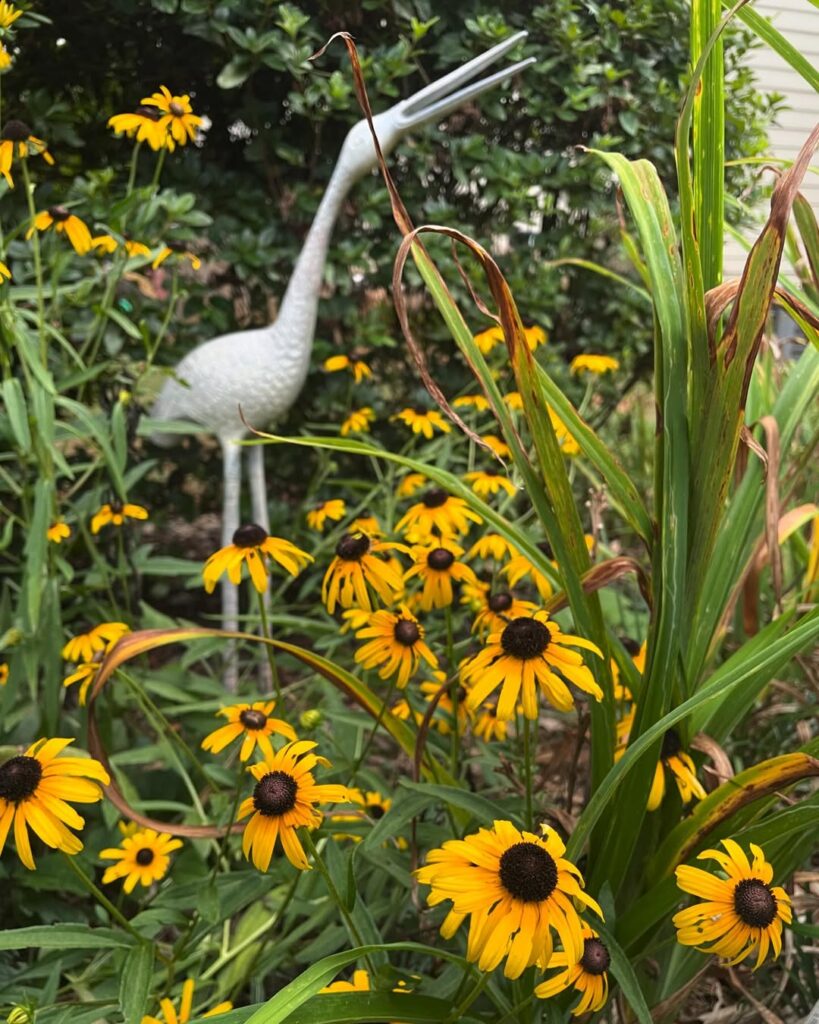
Black-Eyed Susan is a cheerful native wildflower that thrives throughout North Dakota’s prairie landscapes. This hardy perennial produces bright yellow blooms with distinctive dark brown centers from June through October, with peak flowering in mid-summer. As a pioneer species, it rapidly colonizes available ground and serves as an excellent choice for prairie restoration projects. The plant typically performs better in its second year, producing more abundant flowers, and provides valuable seeds for birds while making attractive cut flower arrangements. The bright-yellow flowers can reach 2-3 inches wide and create striking daisy-like displays atop sturdy stems.
- Hardiness: Very cold hardy, native to North Dakota climate zones
- Light: Full sun preferred, though benefits from some afternoon shade for extended blooming
- Water: Medium water needs with high drought tolerance once established
- Soil: Well-drained, moist to dry soils; prefers acidic conditions (pH below 6.8); tolerates clayey loam to sandy loam
- Fertilizer: Low fertility requirements as a native prairie species
- Pest/Disease Resistance: Generally resistant due to native adaptation
- Growth Rate: Fast-growing pioneer species that quickly establishes and spreads
Wild Bergamot

Wild Bergamot is a hardy native perennial that produces fragrant clusters of lavender, pink, or white pompom-like flowers from June through September. This aromatic prairie wildflower typically grows 2-4 feet tall, forming attractive clumps through underground rhizomes. Its tubular, two-lipped flowers arranged in dense globular heads provide excellent nectar sources for butterflies, bees, and hummingbirds, making it invaluable for pollinator gardens.
The plant’s square stems and fragrant foliage make it easily recognizable in both wild and cultivated settings. Wild Bergamot offers multiple benefits beyond ornamental value, including edible leaves and flowers, traditional medicinal uses, and deer resistance due to its aromatic properties. The leaves can be harvested to make a flavorful herbal tea and the flowers are completely edible, adding both culinary versatility and self-sufficiency benefits to any garden.
- Hardiness: USDA zones 3a-9b
- Light: Full sun preferred, tolerates partial shade (minimum 6 hours sunlight)
- Water: Drought tolerant once established, adapts to variable moisture levels
- Soil: Well-drained soils; adapts to clay, rocky, or loam substrates
- Fertilizer: Low maintenance, minimal fertilizer requirements
- Pest/Disease Resistance: Deer resistant, some varieties offer improved powdery mildew resistance
- Growth Rate: Moderate, spreads by rhizomes to form clumps over time
Blanket Flower
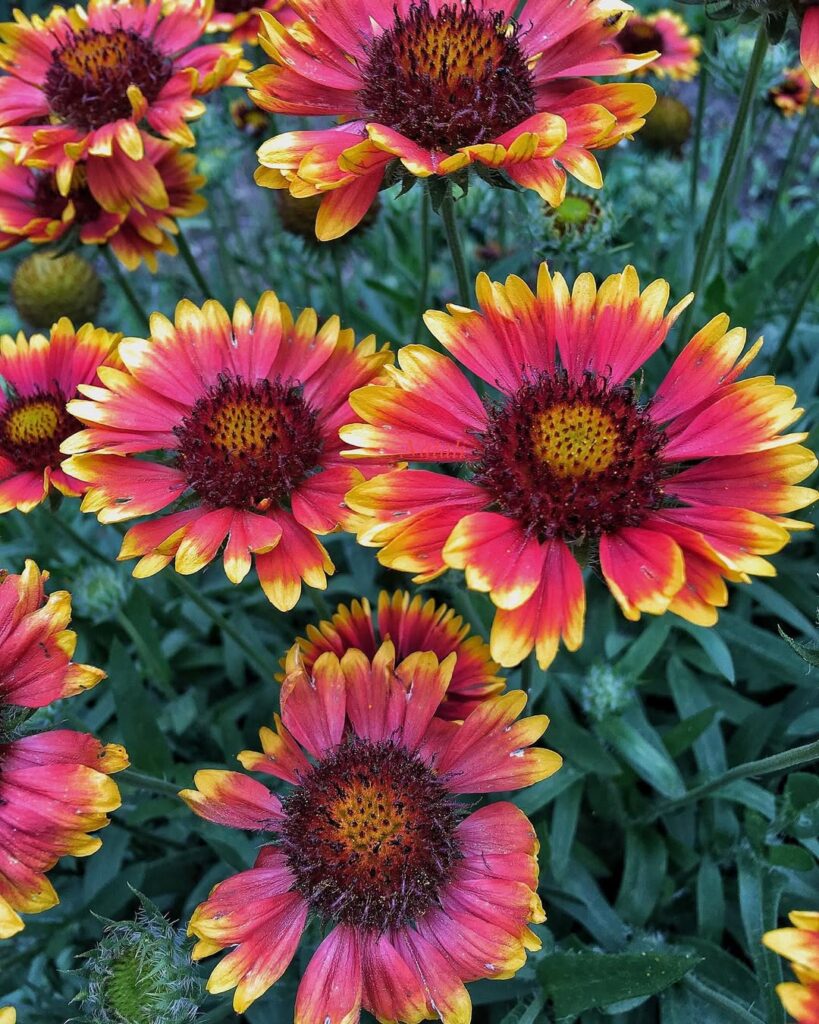
Blanket flower is North Dakota’s only native Gaillardia species, thriving across the state’s upland prairies and dry grasslands. This hardy perennial produces distinctive daisy-like flowers with orange-red centers and bright yellow-tipped petals from June through July. Growing in clumps up to 2 feet tall, it develops from a robust taproot and features gray-green, lance-shaped leaves covered in coarse hairs.
Known for exceptional drought tolerance and adaptability to harsh prairie conditions, blanket flower readily establishes dense colonies that provide valuable habitat for pollinators and seed-eating birds. The species was historically collected by Lewis during the famous Lewis and Clark expedition in 1806 near what is now Lewis and Clark Pass in Montana. Its vibrant blooms and low maintenance requirements make it ideal for xeriscaping, prairie restoration, and naturalized garden areas.
- Hardiness: Zones 3-9, extremely cold tolerant for northern prairie conditions
- Light: Full sun
- Water: Low to very low; extremely drought tolerant once established
- Soil: Well-drained, tolerates poor, rocky, sandy, and alkaline soils
- Fertilizer: None required; thrives in nutrient-poor conditions
- Pest/Disease Resistance: Excellent; deer resistant and rarely affected by pests or diseases
- Growth Rate: Moderate; spreads by reseeding to form colonies
Prairie Phlox
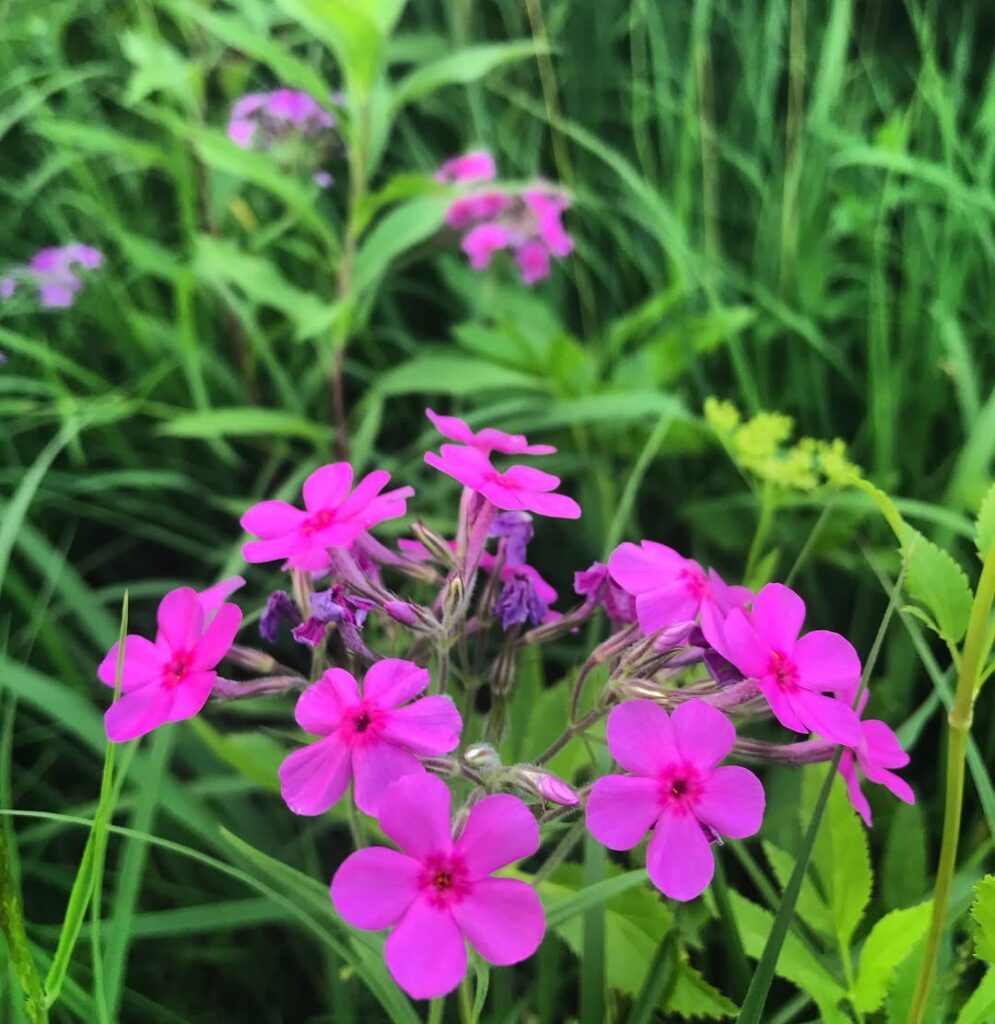
Prairie Phlox (Phlox pilosa) is a charming native wildflower perfectly suited for North Dakota gardens. This compact perennial produces clusters of fragrant pink to lavender flowers during late spring to early summer, creating a delightful display for 4 weeks. Also known as Downy Phlox due to its soft, hairy stems and narrow leaves, it forms neat mounds reaching 6-18 inches tall with a similar spread.
This hardy native thrives in meadows, prairies, and open woodlands throughout the Eastern United States. Prairie Phlox attracts long-tongued bees, butterflies, and skippers with its deep-throated, nectar-rich flowers, making it an excellent choice for pollinator gardens while adding natural beauty to residential landscapes. The plant’s versatility allows it to adapt to various gardening situations, making it suitable for front rows or edges in taller landscaped gardens.
- Hardiness: USDA Zones 4-9
- Light: Full sun to partial shade
- Water: Slightly moist to slightly dry; drought tolerant once established
- Soil: Well-draining sandy loam to clay loam; tolerates rocky conditions
- Fertilizer: Low fertilizer needs; thrives in average garden soil
- Pest/Disease Resistance: Good resistance; not deer resistant
- Growth Rate: Moderate; reaches 1-2 feet at maturity
Cold-Tolerant Native Trees
North Dakota’s harsh winters demand trees that can withstand extreme cold while thriving in challenging conditions. These native species offer proven resilience and natural adaptation. The Quaking Aspen stands out as a fast-growing option that adapts well to various conditions while providing stunning fall colors ranging from gold to orange.
American Elm

The American elm is a magnificent native tree that once graced communities throughout North Dakota before Dutch elm disease dramatically reduced populations. This extremely hardy species can withstand temperatures as low as -40°F, making it well-suited to the state’s harsh winters. Naturally occurring from Nova Scotia to Alberta and south to Florida and Texas, American elm thrives in diverse habitats from rich bottomlands to well-drained uplands.
Known for creating graceful archways and providing ample shade, American elm remains an important species for conservation efforts. Its wind-dispersed seeds germinate readily without cold stratification, typically fruiting from late spring through early summer. While greatest growth occurs in northeastern regions, this adaptable native continues to be evaluated and recommended for North Dakota plantings.
Modern American elm cultivars like ‘Princeton’ and ‘Valley Forge’ offer high DED resistance while maintaining the species’ exceptional cold hardiness for North Dakota conditions.
- Hardiness: USDA zones 2-9, tolerates temperatures to -40°F
- Light: Full sun to partial shade
- Water: Moderate to high moisture; thrives near water sources but adaptable to various moisture levels
- Soil: Rich bottomlands and floodplains preferred; adaptable to well-drained upland soils and various soil types
- Fertilizer: Low maintenance; benefits from organic matter in poor soils
- Pest/Disease Resistance: Highly susceptible to Dutch elm disease; elm leaf beetle can be problematic
- Growth Rate: Moderate to fast growth rate with large mature size potential
Green Ash
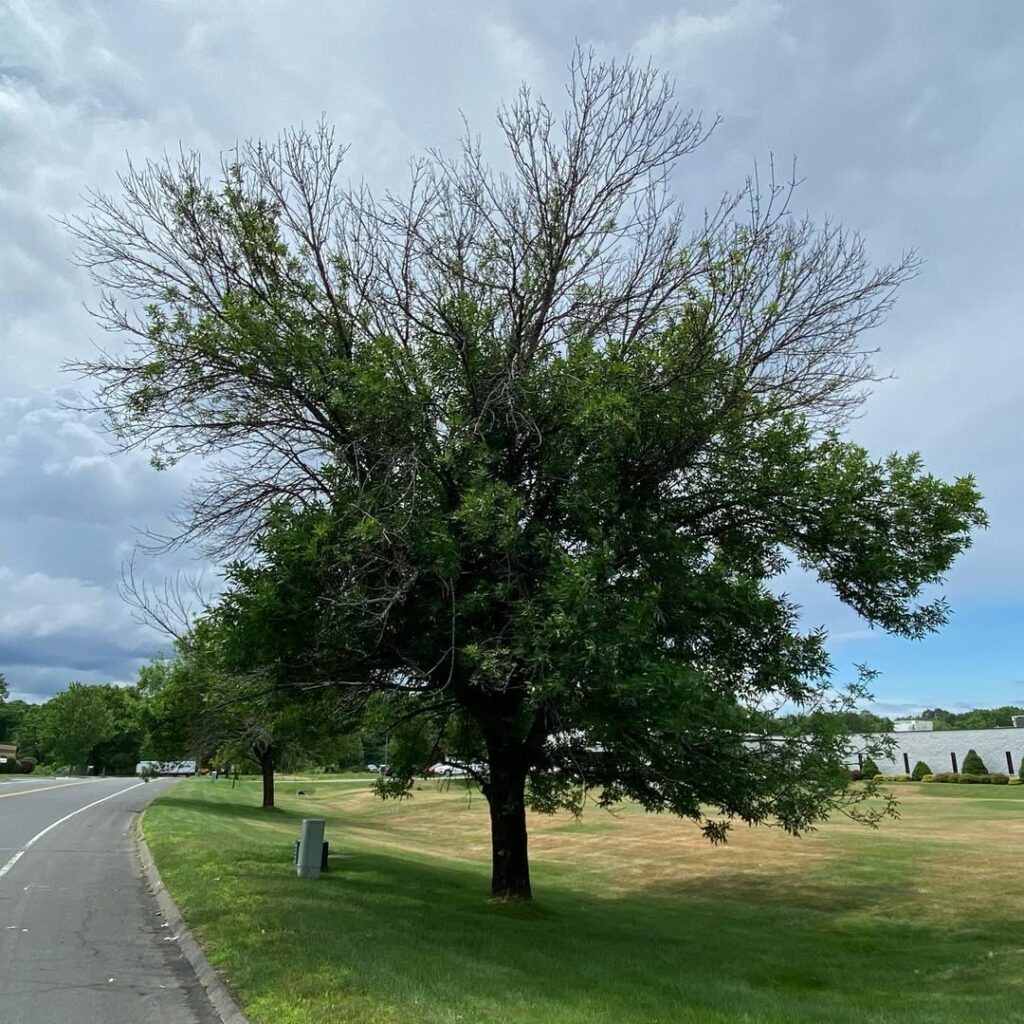
Green Ash is a medium to large deciduous tree that reaches 50-70 feet tall with a spread of 35-50 feet. This North Dakota native features an open, irregular crown and displays beautiful clear yellow fall color. Its pinnately compound leaves have 5-9 sharply-toothed leaflets and create excellent shade. The tree produces winged seeds that provide food for wildlife including birds and squirrels.
Extremely hardy and adaptable, Green Ash tolerates climatic extremes and has become a popular replacement for American Elm in urban plantings. It thrives in North Dakota’s challenging conditions, showing resistance to drought and alkaline soils while growing relatively fast once established. The strong, hard wood is valued for making tool handles and baseball bats, though it’s considered less desirable than white ash.
- Hardiness: USDA zones 3-9, extremely hardy to climatic extremes
- Light: Full sun to partial shade
- Water: Drought tolerant once established, moderate water needs
- Soil: Adaptable to various soil types, tolerates high clay content and alkaline conditions
- Fertilizer: Low maintenance, typically does not require regular fertilization
- Pest/Disease Resistance: Generally resistant to most pests and diseases
- Growth Rate: Medium to fast growth rate once established
Paper Birch
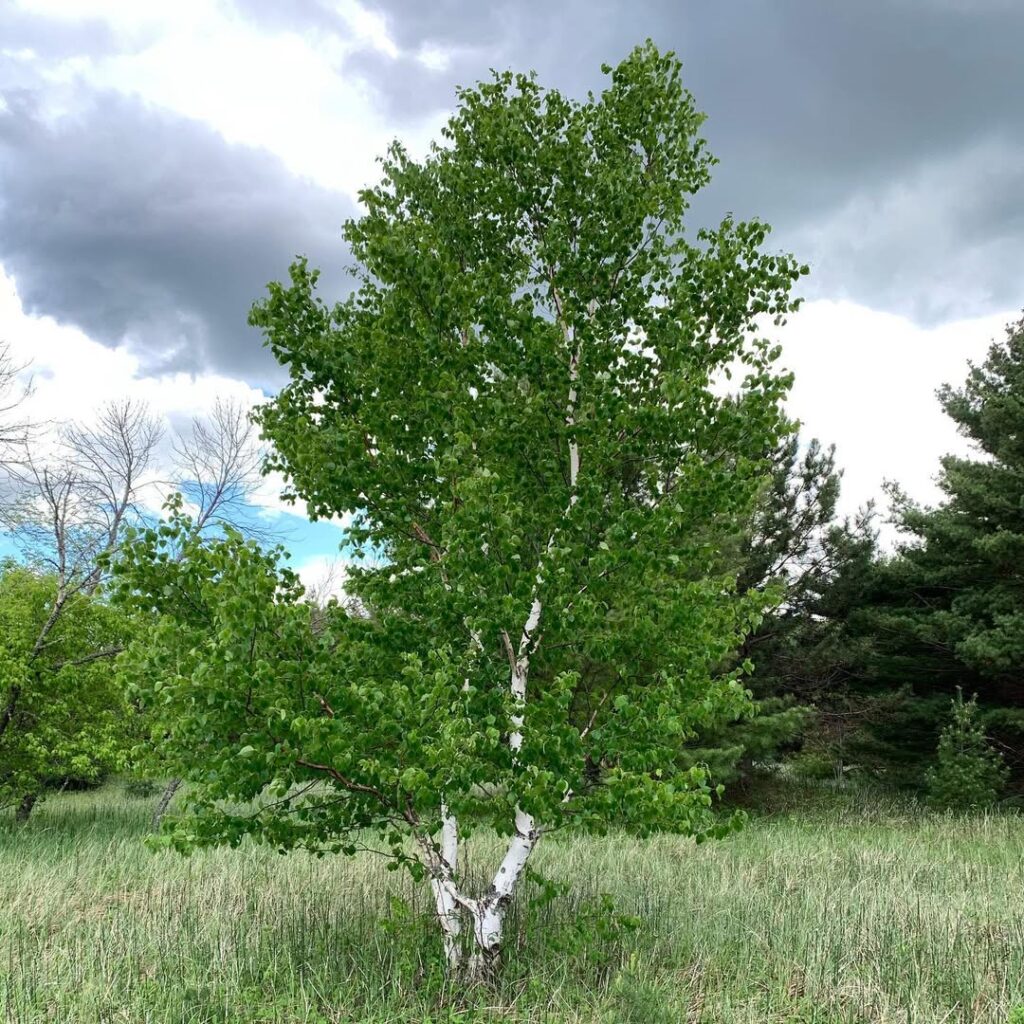
Paper birch is one of North Dakota’s most recognizable native trees, prized for its distinctive white bark that peels in papery sheets. This cold-hardy species typically reaches 50-70 feet in height and displays brilliant yellow fall color. As a pioneer species, it quickly establishes in disturbed areas and provides valuable wildlife habitat.
Historically significant to Indigenous peoples for canoe construction and shelter, paper birch remains popular today as an ornamental tree. Though relatively short-lived at 80-100 years, it offers rapid initial growth and exceptional cold tolerance, making it well-suited to North Dakota’s harsh continental climate. The tree produces yellow catkins in April as its flowers bloom before the leaves emerge.
- Hardiness: USDA Zones 2-6, extremely cold tolerant
- Light: Full sun required, shade intolerant
- Water: Consistent moisture needed, sensitive to drought
- Soil: Moist, well-drained soils; tolerates sandy or gravelly conditions
- Fertilizer: Generally not required in natural settings
- Pest/Disease Resistance: Moderate; susceptible to bronze birch borer in stressed conditions
- Growth Rate: Fast initial growth, early maturity
Bur Oak

The Bur Oak is North Dakota’s most prominent native tree, accounting for approximately 19% of the state’s forest land. Known for its exceptional cold tolerance and drought resistance, this hardy species thrives throughout nearly all of North Dakota, growing from scrubby forms on dry sites to magnificent specimens reaching 85 feet tall on favorable locations.
This adaptable oak produces the largest acorns of all native species, providing essential wildlife food while developing into a broad-crowned shade tree. Its deeply lobed leaves and stout branching structure make it well-suited for large landscapes, parks, and shelterbelts across the region. Considered one of the most majestic large oaks, this species develops into an impressive specimen with a long lifespan that makes it a valuable addition to any large-scale planting.
- Hardiness: USDA Zones 3-8, excellent cold tolerance for North Dakota’s climate
- Light: Full sun conditions preferred
- Water: Very drought tolerant once established, suitable for dry conditions
- Soil: Adaptable to various soils from dry sandy plains to fertile limestone soils and moist bottomlands
- Fertilizer: Low maintenance, typically does not require supplemental fertilization
- Pest/Disease Resistance: Generally resistant to common oak problems
- Growth Rate: Slow to moderate, 1-2 feet per year on favorable sites once established
Quaking Aspen
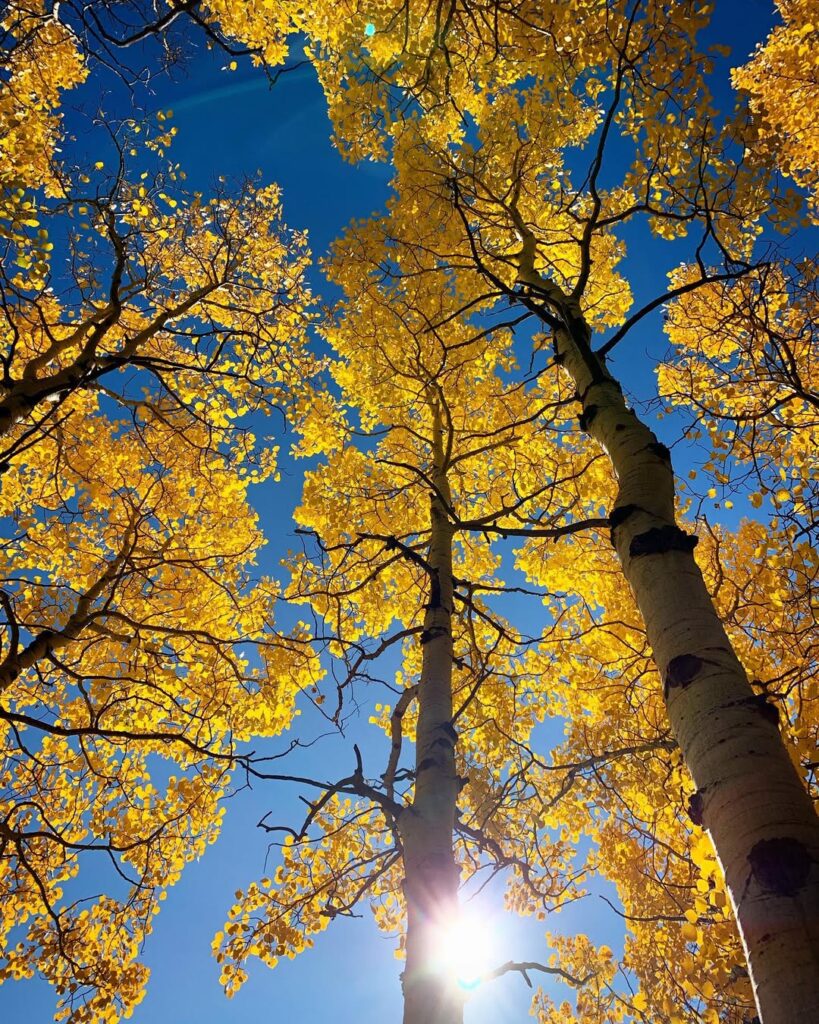
Quaking aspen (Populus tremuloides) is a cold-tolerant deciduous tree native to North Dakota and much of North America. This aggressive pioneer species readily establishes in disturbed areas and is distinguished by its flattened leaf stalks that cause the leaves to tremble or “quake” in light breezes. A member of the willow family, quaking aspen possesses the most extensive native range of any North American tree.
As a hardy native species, quaking aspen thrives in North Dakota’s challenging climate and serves as an excellent choice for naturalized landscapes. The tree commonly occurs in mixed northern hardwoods and riparian zones throughout its range, making it well-adapted to various local growing conditions. Young trees feature smooth, white to cream bark that develops dark ridges and furrows as the tree matures.
- Hardiness: Extremely cold hardy, native to North Dakota’s climate zones
- Light: Full sun to partial shade
- Water: Moderate to high moisture requirements, tolerates wet soils
- Soil: Adaptable to various soil types, prefers well-draining soils
- Fertilizer: Generally does not require supplemental fertilization when grown in native conditions
- Pest/Disease Resistance: Moderate resistance, may be susceptible to some canker diseases and boring insects
- Growth Rate: Fast-growing pioneer species
Hardy Shrubs for Winter Survival
Beyond trees, North Dakota gardeners need resilient shrubs that withstand harsh winters while providing structure, wildlife habitat, and seasonal interest throughout the challenging growing season. These native shrubs create essential shelter for local wildlife while establishing natural windbreaks and privacy screens that complement the state’s flowering and shade trees.
Serviceberry
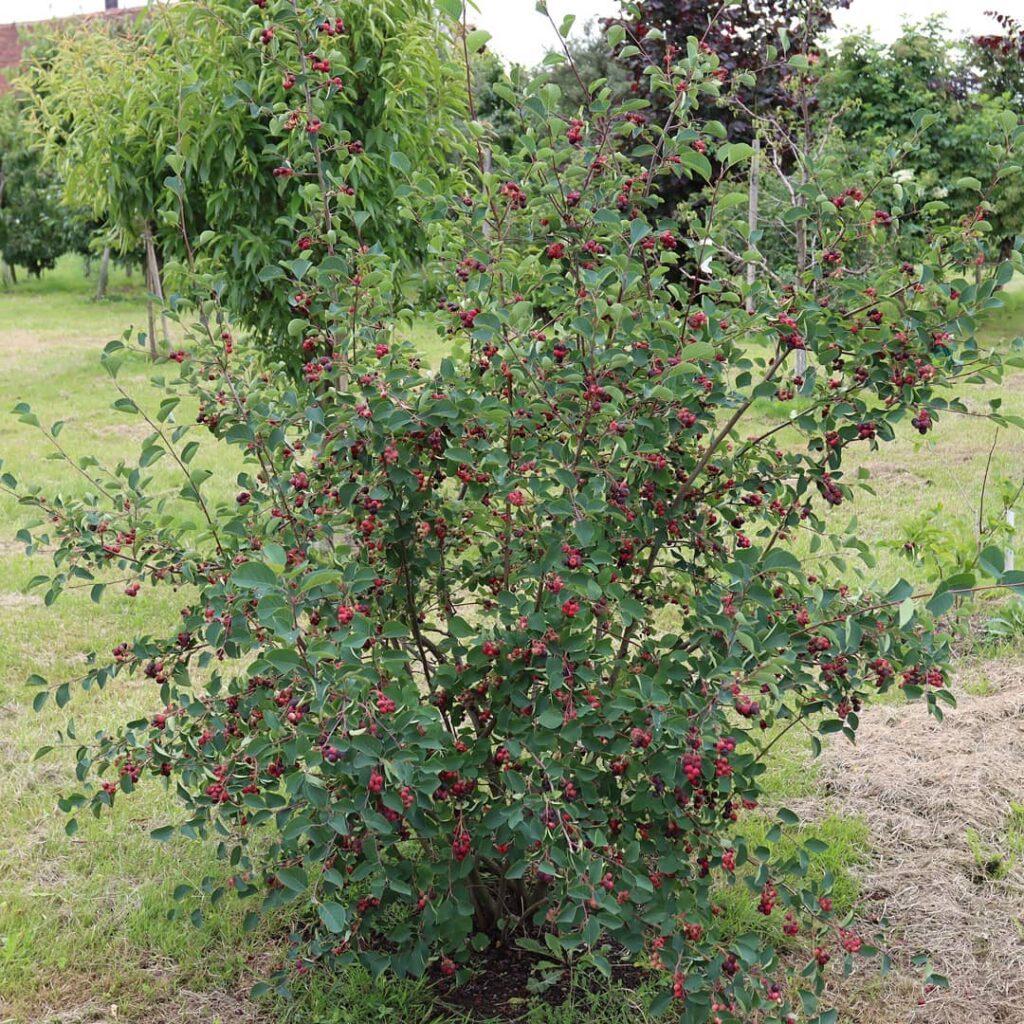
Serviceberry (Amelanchier alnifolia) is an exceptional cold-hardy native shrub perfectly suited for North Dakota’s harsh winters, thriving in USDA Zones 2-6. This versatile plant serves multiple purposes as an ornamental specimen, wildlife habitat, and edible fruit producer. Growing 3-26 feet tall depending on variety, serviceberry offers year-round interest with early spring clusters of white to pale pink flowers, attractive fall foliage, and sweet edible berries.
The plant’s adaptability makes it invaluable for challenging North Dakota conditions, tolerating both drought and wet soils once established. Its natural suckering habit allows for easy propagation and renewal, while providing excellent screening or hedge potential. Serviceberry supports local ecosystems by attracting pollinators and feeding wildlife with its nutritious summer berries. This attractive understory tree works particularly well in woodland margins and fits seamlessly into native plant areas.
- Hardiness: USDA Zones 2-6, extremely cold tolerant
- Light: Full sun preferred, tolerates partial shade
- Water: Regular watering during establishment, drought tolerant once mature
- Soil: Wide range including clay, sandy, and limestone soils; prefers well-drained
- Fertilizer: Low maintenance, no special fertilization requirements
- Pest/Disease Resistance: Generally resistant with few serious issues
- Growth Rate: Moderate, reaches maturity in 3-5 years
Chokecherry
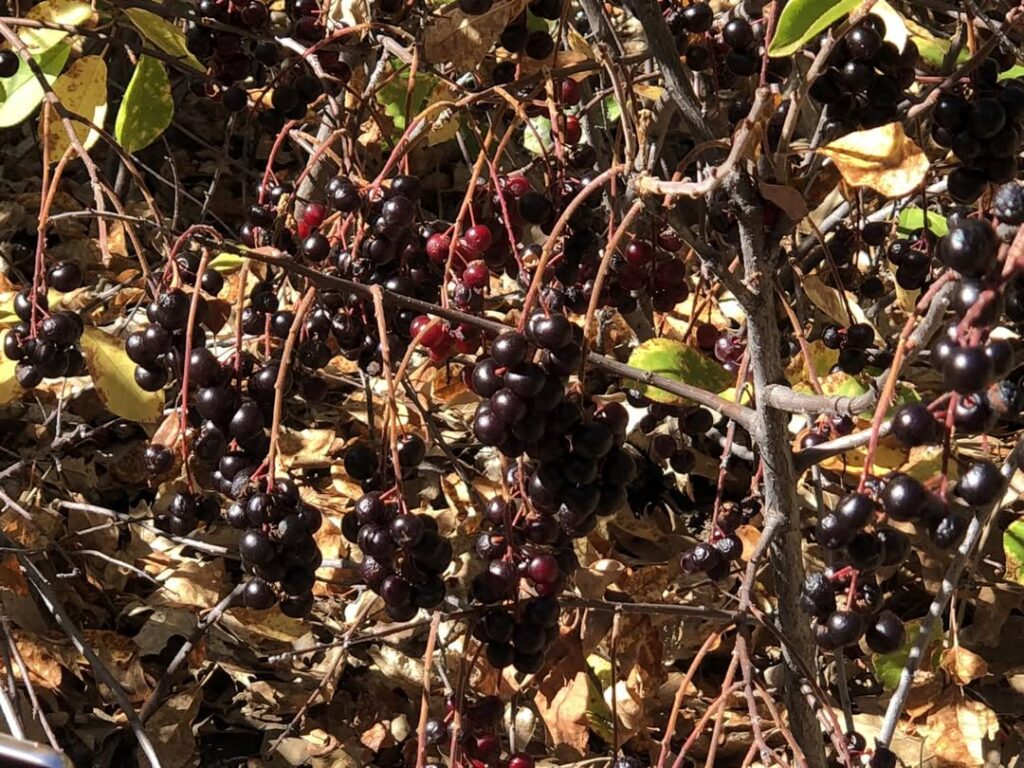
Chokecherry is an exceptionally hardy native shrub or small tree that thrives in North Dakota’s harsh winter climate. Reaching up to 30 feet in height, it forms dense thickets through extensive rhizome systems and produces clusters of white spring flowers followed by small drupes that ripen from red to dark purple or black. This versatile plant provides excellent wildlife habitat while offering ornamental value with its seasonal blooms and autumn foliage.
The species demonstrates remarkable adaptability to various growing conditions, from rich moist soils to disturbed areas and woodland borders. Its fruits, though astringent when raw, can be processed into preserves and jellies, continuing a tradition of use by Native Americans who valued both its nutritional and medicinal properties. The plant shows exceptional shade tolerance and resilience under variable growing conditions throughout its range.
- Hardiness: Excellent winter hardiness for North Dakota climate, native perennial adapted to harsh conditions
- Light: Requires generous sunlight for ideal fruit production
- Water: Tolerates both wet and dry conditions, requires minimum 15 inches annual precipitation for establishment
- Soil: Thrives in various soil types and textures, adaptable to rich moist soils, thickets, and disturbed areas
- Fertilizer: No specific fertilizer requirements mentioned, adapted to native soil conditions
- Pest/Disease Resistance: Hosts tent caterpillars but generally resilient as native species
- Growth Rate: Establishes satisfactorily from nursery seedlings, spreads through extensive rhizome system up to 35 feet from base
American Hazelnut
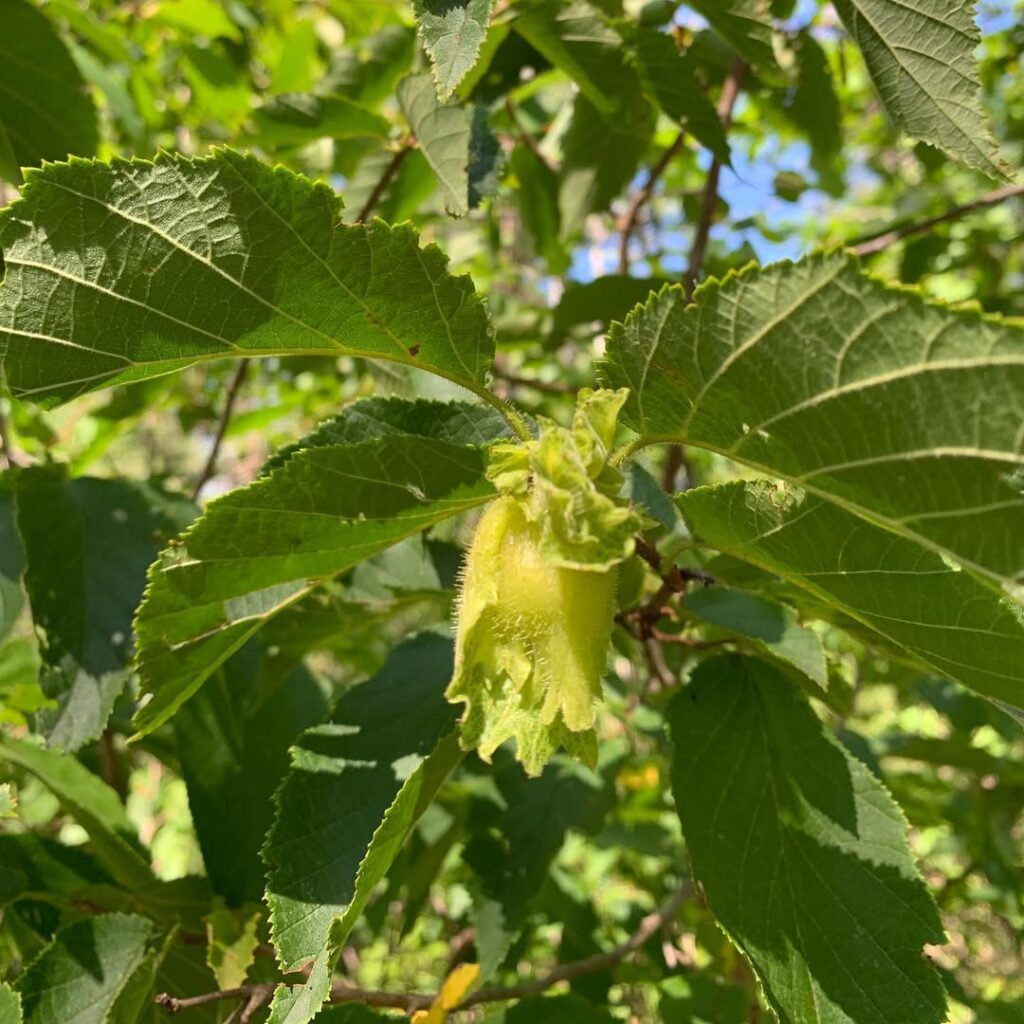
American Hazelnut is a cold-hardy, multi-stemmed shrub that forms dense thickets reaching 8-16 feet tall. This native plant produces edible nuts while providing exceptional wildlife value, serving as food and shelter for numerous birds and mammals. Its adaptable nature and seasonal interest make it an excellent choice for North Dakota landscapes, offering colorful fall foliage in shades of copper, yellow, orange, and red while functioning effectively as windbreaks or hedgerows. As a unisex species, American Hazelnut has separate male and female parts on the same branch, with planting 3-5 shrubs recommended for optimal nut production.
- Hardiness: Zones 4-9, well-suited for North Dakota’s harsh winters
- Light: Full sun to partial shade
- Water: Tolerates dry, medium, or moist soil conditions
- Soil: Adaptable to clay, loam, and sand; rhizomatous root system aids soil stabilization
- Fertilizer: Low maintenance; no special fertilizer requirements
- Pest/Disease Resistance: Generally resistant to most pests and diseases
- Growth Rate: Moderate growth rate with thicket-forming, spreading habit
Red-Osier Dogwood

Red-Osier Dogwood is an exceptional native shrub perfectly suited for North Dakota’s harsh winters. This multi-stemmed deciduous plant grows 6-12 feet tall and provides year-round interest with its vibrant red stems that create stunning winter contrast against snow and evergreens. The shrub produces clusters of yellowish-white flowers in late spring, followed by bluish-white berries that provide essential food for wildlife. It also serves as a larval host for the Spring Azure butterfly, supporting local pollinator populations.
Beyond its ornamental value, Red-Osier Dogwood offers tremendous ecological benefits, supporting 47 bird species and numerous mammals with food and shelter. Its fast growth rate and spreading habit through underground stems make it excellent for erosion control and naturalized plantings. The shrub thrives in challenging conditions and responds well to pruning, which enhances the brilliant red stem color that makes it a standout feature in winter landscapes.
- Hardiness: USDA zones 2-7, extremely cold-hardy for North Dakota conditions
- Light: Full sun to partial shade (4-6 hours daily)
- Water: Prefers moist, well-drained soil but tolerates wet sites and occasional flooding
- Soil: Adaptable to various conditions including alkaline soil, clay soil, and heavy clay
- Fertilizer: Low maintenance, typically requires no supplemental fertilization
- Pest/Disease Resistance: Generally resistant, though may be affected by dogwood sawfly
- Growth Rate: Fast-growing for quick landscape establishment
Elderberry
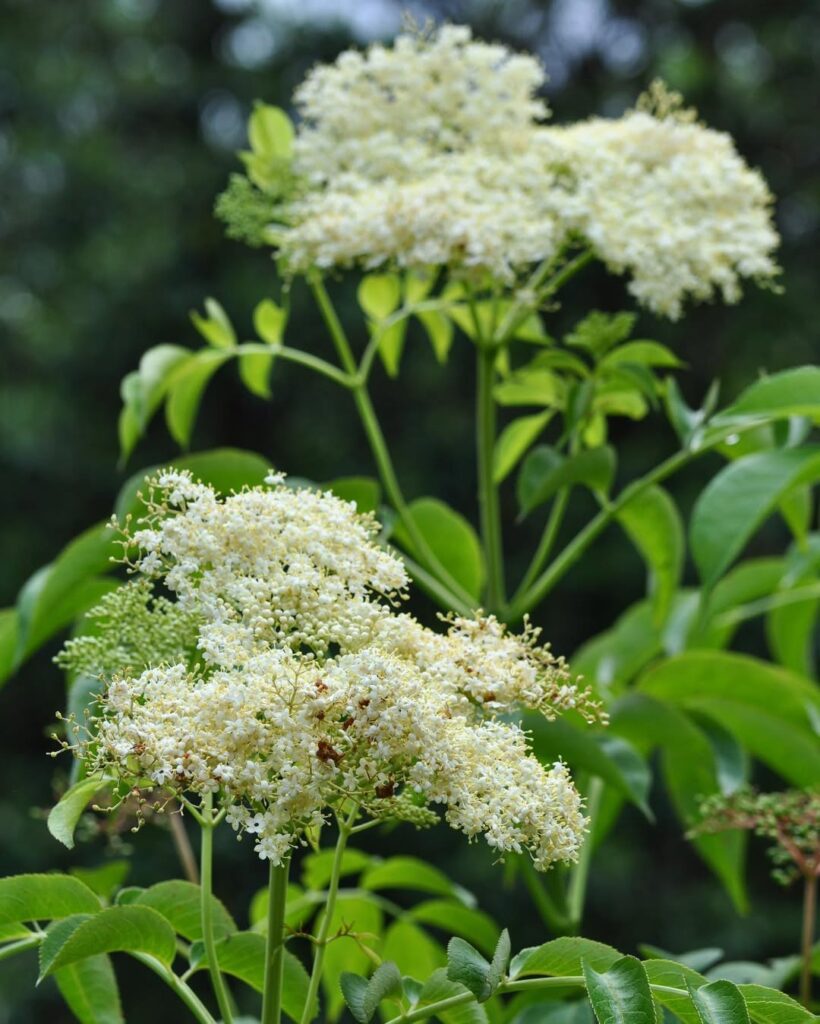
Elderberry stands out as an exceptionally hardy native shrub that thrives in North Dakota’s harsh climate, surviving temperatures down to USDA Zone 3. This versatile deciduous shrub rapidly establishes itself, often growing over 2 feet in its first year and eventually reaching 5-12 feet tall with dense, spreading growth that forms protective thickets.
Beyond its impressive cold tolerance, elderberry offers year-round interest with clusters of white summer flowers that attract pollinators, followed by purple-black berries that provide essential wildlife food. The shrub’s adaptability to various soil conditions, from wet streambanks to drier uplands, makes it invaluable for erosion control and naturalized plantings. The berries are rich in anti-inflammatory compounds and have traditionally been used to combat cold and flu viruses.
- Hardiness: USDA Zone 3; survives rapid temperature changes and recovers quickly from winter damage
- Light: Full sun to partial shade; tolerates a wide range of light conditions
- Water: Adaptable from moist to wet conditions; tolerates both streambank moisture and drier upland soils
- Soil: Prefers rich, moist, slightly acidic soil but adapts to poor soils; tolerates wet conditions and juglone presence
- Fertilizer: Low maintenance; thrives without supplemental feeding in most soils
- Pest/Disease Resistance: Functions as natural pest repellent; generally disease-resistant
- Growth Rate: Rapid establishment with over 2 feet of growth in first year
Selecting the Right Native Plants for Your Garden
Three critical factors determine your success when selecting native plants for North Dakota gardens: climate tolerance, site conditions, and your specific gardening goals. Start by evaluating your hardiness zone requirements, as regional climate adaptations vary between zones 3 and 4.
Next, assess your soil type and drainage patterns. Drought-tolerant species like Scarlet Globemallow thrive in well-drained sites, while Swamp Milkweed prefers moisture-rich areas.
Consider your garden’s purpose too. Want pollinator support? Choose milkweeds and coneflowers. Need dramatic height? Cutleaf Coneflower reaches 7 feet. Native plants also provide essential food sources for beneficial insects and birds throughout the growing season. Effective plant selection strategies match species characteristics with your site’s unique conditions.
Frequently Asked Questions
How Do I Propagate Native North Dakota Plants From Seeds?
Native plants boost biodiversity by 400%! You’ll succeed using proper seed collection techniques during mature phases, then applying germination methods like stratification for dormant seeds and maintaining consistent moisture until establishment occurs.
When Is the Best Time to Plant Native Species in North Dakota?
You’ll find fall planting works best for most native North Dakota perennials since they establish strong roots before winter. However, spring planting during April’s Native Plant Month also succeeds when you plant after frost danger passes.
Do Native Plants Require Special Fertilizers or Soil Amendments?
Ironically, you’ll spend less on native plant fertilization than exotic species. These hardy survivors typically don’t need special soil amendment techniques since they’ve already adapted to your area’s natural conditions perfectly.
How Much Water Do Established Native Plants Need During Summer?
You’ll need minimal water for established natives during summer – typically one inch monthly. Their drought tolerance means you can use deep, infrequent irrigation techniques rather than frequent watering sessions.
Can Native North Dakota Plants Survive Without Winter Protection?
You’ll find that native North Dakota plants demonstrate exceptional winter resilience without additional protection. Their natural plant hardiness allows them to survive extreme cold through dormancy strategies and deep root systems developed over thousands of years.
